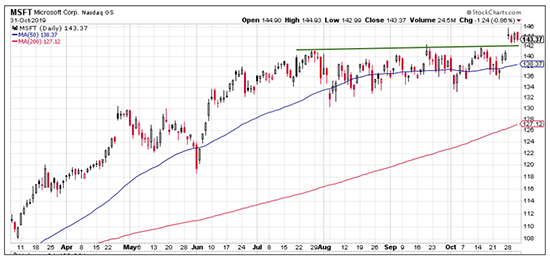The world of big tech looks like a chaotic, bruising, conflicted hot mess right now. And then there is Microsoft, floating above the fray.
The Redmond, Wash.-based giant not only vies closely with Apple for the title of “most valuable company in the world” — both of them have a trillion-plus in market cap — it seemingly skates through a hostile political environment with no drama.
All the other tech giants have headaches or something worse. Amazon, for example, is wary of being sucked into an antitrust lawsuit. So is Facebook. Apple, meanwhile, is dealing with supply chain exposure and revenue reliance on China with trade war vulnerabilities tied into that, not to mention the challenge of declining iPhone revenues in a peak-smartphone world.
It just keeps going: Netflix is caught up in the streaming wars as rivals burn cash. Google is facing an investigation from the attorneys general of dozens of states (and getting the hairy eyeball from Europe). Twitter shares recently fell 20% on bad news buried within an earnings report. Facebook’s CEO has been called out multiple times by Congress. Social media, on the whole, is in the midst of a polarizing debate: Free speech on the one hand, Democracy under threat on the other.
The list goes on as anti-tech drumbeats grow louder. Everywhere you look, there seems to be a “techlash” (a newly popular word combining “technology” and “backlash”).
And yet Microsoft just hums along, a company worth $1.1 trillion, with no government regulators breathing down its neck and no bloody battles to speak off. The other big tech companies keep getting called out while taking potshots at each other — while Microsoft stays mum and piles up cash.
The Microsoft share price is playing nicely, too. MSFT recently saw an upside breakout from a four-month sideways range, as the chart below shows. New all-time highs are back in the mix, and the multi-month nature of the sideways basing period suggests the potential for a 15 to 20% rise.
 |
Microsoft is also picking up new strategic wins, like being awarded a $10 billion cloud-computing contract from the Pentagon and Department of Defense (DoD).
It was widely expected that the $10 billion contract would go to Amazon Web Services (AWS), the cloud computing arm of Amazon. AWS has a relationship with the CIA and a far larger cloud service market share (roughly 48% to Microsoft’s 15%).
The contract award came with some political controversy — Amazon may well fight back in court — but Microsoft is a justifiable choice and will benefit no matter what happens. Though Microsoft was No. 2 in the cloud, it was far behind the curve versus Amazon in terms of government trust. Now, with the Pentagon contract as a calling card, Microsoft can drum up business with other government agencies.
Why is a trillion-dollar tech juggernaut being left to roam freely? In part because Microsoft’s business line is wonderfully isolated from the thorny issues of the day.
The political questions around democracy and free speech are dominating Washington, and Microsoft has nothing to do with that. The topic of cryptocurrencies and global stablecoins has made a splash thanks to Libra, but Microsoft has no skin in the cryptocurrency game. E-commerce platforms are facing questions on third-party vendors, but Microsoft doesn’t play in that space.
Microsoft has taken its lumps in the past. The company went through its own bruising antitrust review nearly two decades ago. There was a looming threat to break the company up, but it never happened.
Twenty years back, Microsoft was seen as a predator — a bully putting pressure on small and vulnerable tech companies, finding ways to abuse its market power or, at minimum, push the envelope. In some ways, Microsoft is exactly the same company today. It’s just that few are paying attention.
For example, Microsoft has a product called Teams that competes on a head-to-head basis with team-based chat and video applications — the offerings of rival public companies Slack and Zoom. Microsoft gives away its Teams product on a cheap-to-free basis, using it as part of a bundle strategy along with other paid products like Office 365.
Critics argue this is comparable to what Microsoft did 20 years ago with Internet Explorer, when the goal was to kill off the Netscape Navigator browser. Today, the targets are Slack and Zoom — but there are so many other battles to fight, regulators can’t be bothered to go after Microsoft on this.
In its most recent earnings report, Wall Street analysts were effusive. Revenue and profits both beat expectations. Microsoft should be able to “weather any storm,” said one Jefferies analyst. The company “beat virtually every metric,” said a Bernstein analyst. The company “continues to fire on virtually all cylinders,” said a William Blair analyst.
Microsoft is a consensus pick at this point — meaning every large money manager knows the story — but MSFT is also one of the last great-looking large caps without heavy baggage attached.
And so, when you combine the excellent positioning of Microsoft with the recent price breakout from a multi-month sideways base, it wouldn’t be surprising to see a 15% to 20% uptrend from here, toward the cluster of analyst targets in the $160 to $170 range.
TradeSmith Research Team





